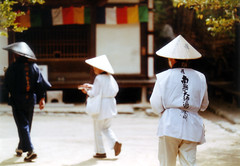
Having spent ten days travelling around Shikoku this Golden Week, visiting three of the four prefectures, here are my recommendations in descending order: 1. Spend a night a Chiiori.
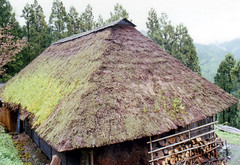 If you have the time, and are able to make it to the somewhat remote Iya Valley 祖谷, I highly recommend spending a night or more at Chiiori. Chiiori is a traditional thatched-roof farm house near Miune-san 三嶺山 in Higashi-Iya 東祖谷 village. It is maintained by a group of volunteers, and is more of a private residence or cooperative than a hotel. There are various work weekends throughout the year where you can help cut thatch for a new roof, help garden, or other work needed to keep the 300-year old structure standing. All guests sleep in the main hall on futons. Normally a Japanese house such as this would be partitioned into a few smaller rooms, but when Alex Kerr bought the place thirty years ago, he removed them to bring more sunlight into the rest of the house. Still, it is quite dark inside and adds to the romance of the place. Sitting around the hearth drinking tea, smoke billowing up to the rafters, rain and mist obscuring the trees and mountains was a wonderful experience.
If you have the time, and are able to make it to the somewhat remote Iya Valley 祖谷, I highly recommend spending a night or more at Chiiori. Chiiori is a traditional thatched-roof farm house near Miune-san 三嶺山 in Higashi-Iya 東祖谷 village. It is maintained by a group of volunteers, and is more of a private residence or cooperative than a hotel. There are various work weekends throughout the year where you can help cut thatch for a new roof, help garden, or other work needed to keep the 300-year old structure standing. All guests sleep in the main hall on futons. Normally a Japanese house such as this would be partitioned into a few smaller rooms, but when Alex Kerr bought the place thirty years ago, he removed them to bring more sunlight into the rest of the house. Still, it is quite dark inside and adds to the romance of the place. Sitting around the hearth drinking tea, smoke billowing up to the rafters, rain and mist obscuring the trees and mountains was a wonderful experience.
2. Dogo onsen 道後温泉. Not the most relaxing bath in Japan, but perhaps the nicest bathhouse building. We decided to visit Dogo onsen around dinner time when the place should’ve been less busy but it was still packed. Shoulder to shoulder naked old men, hot, hot water. Along with Beppu別府 it is probably the most well known hot spring in Japan but unlike Dogo, Beppu spreads the tourists out over dozens of baths. The old, carved granite baths were impressive but more enjoyable was the tea, biscuits and atmosphere in the tatami room upstairs of the ‘kami no yu’ 神の湯, “Bath of the gods.”
3. Shin-Iya-Onsen, Kazura-bashi Hotel 新祖谷温泉 かずら橋ホテル. This lovely onsen has to rate as one of my favourites. It is newer than the other baths in the Iya Valley but it has been especially well done. On the third floor of the hotel are the indoor baths and sauna, but catch the lift up the side of the mountain to the rotenburo 露天風呂(outdoor baths) and teahouse. The mens’ and womens’ rotenburo have stellar views of the valley below. While we were there it was lightly raining and quite peaceful. Something surprising about this hotel is that it has a mixed bath or konyoku混浴. I believe that these are rather rare in Japan nowadays and only a few old ones exist in rural Oita, Kumamoto and Kagoshima. After our bath the three of us relaxed on the teahouse porch, soaked our feet in a foot bath and enjoyed the view. Later we went into the thatched roof teahouse for some complimentary tea. For 1,000 yen this bath was well worth it.
4. Oku-Iya Kazura-bashi (Vine Bridges)奥祖谷かずら橋.
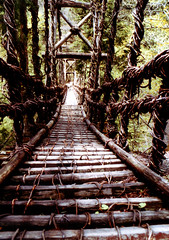 No trip to the Iya Valley would be complete without visiting the vine bridges. We decided to visit the less touristed “fufu” husband and wife bridges on the way to Mount Tsurugi. The vines on the bridges are replaced every three years and are supported with steel cables. In the past the bridged were just made of vines and bamboo so that they could be easy to sever for the Heike warriors fleeing the Shogun’s army.
No trip to the Iya Valley would be complete without visiting the vine bridges. We decided to visit the less touristed “fufu” husband and wife bridges on the way to Mount Tsurugi. The vines on the bridges are replaced every three years and are supported with steel cables. In the past the bridged were just made of vines and bamboo so that they could be easy to sever for the Heike warriors fleeing the Shogun’s army.
5. Iya-kei祖谷渓. The actual Iya gorge is deep, natural, and beautiful. However, due to the roads, houses, and other construction it lacks the mystical feeling apparent in Yakushima (especially in the early morning mist around Miyanoura-dake). It is easy to imagine how the area must have been, and how inaccessible it was when the Heike warriors fled here. Wild, isolated, lost Japan.
6. Hiking from Tsurugi-san剣山 to Miune-san 三嶺山.
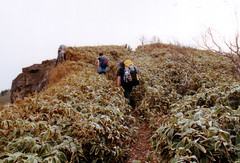 Tsurugi-san is a sacred mountain in Japan, where the Heike warriors buried their emperor’s sword after their defeat at Shimonoseki. With a chair lift up, the summit can be a little crowded, but most are day-trippers and the trail to Miune is relatively clear. The hike is quite easy in most parts and the trail is well marked in all but a few spots. Thick bamboo grass blankets many of the mountains, leaving only a thin, saw-tooth path leading off into the distance over the next peak. The Miune Hutte has been rebuilt since the Lonely Planet Hiking in Japan was published, and is quite nice but the toilets are not good. (The other mountain huts or yama-goya do not have outhouses at all.)
Tsurugi-san is a sacred mountain in Japan, where the Heike warriors buried their emperor’s sword after their defeat at Shimonoseki. With a chair lift up, the summit can be a little crowded, but most are day-trippers and the trail to Miune is relatively clear. The hike is quite easy in most parts and the trail is well marked in all but a few spots. Thick bamboo grass blankets many of the mountains, leaving only a thin, saw-tooth path leading off into the distance over the next peak. The Miune Hutte has been rebuilt since the Lonely Planet Hiking in Japan was published, and is quite nice but the toilets are not good. (The other mountain huts or yama-goya do not have outhouses at all.)
7. Shimanto-gawa 四万十川.
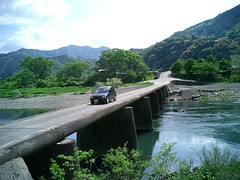 The last free flowing river in Japan is something to see. We noticed a dam on one its tributaries and wondered if this distinction should stand. The river is only 196 km long, which makes it rather sad that it is the last free flowing river. As construction is the lifeblood of rural Japan, the river had a plethora of bridges, but no dams, diversions or straightenings so I guess that is ok. We camped along the upper reach of the river and had a brief swim. The area is quite popular for kayaking just downstream from where we camped. Coming from a place like Canada, the Shimanto was nothing special and what I found more interesting were the 22 submersible bridges. Most of the bridge decks were 3-5 metres above the water level, and I could imagine the smaller ones being submerged by a metre or so during typhoon season. One bridge we saw actually had a few sections washed away, which made me think of the forces acting upon it. A log jam in one of those bridges could be disastrous, but I imagine that the area is so thoroughly managed that this is not a problem. In North America, we’ve stopped removing large woody debris from rivers (to prevent jams) because we’ve realized that they contribute to the morphology of rivers, creating deep, cool pools, and providing shade and shelter for fish.
The last free flowing river in Japan is something to see. We noticed a dam on one its tributaries and wondered if this distinction should stand. The river is only 196 km long, which makes it rather sad that it is the last free flowing river. As construction is the lifeblood of rural Japan, the river had a plethora of bridges, but no dams, diversions or straightenings so I guess that is ok. We camped along the upper reach of the river and had a brief swim. The area is quite popular for kayaking just downstream from where we camped. Coming from a place like Canada, the Shimanto was nothing special and what I found more interesting were the 22 submersible bridges. Most of the bridge decks were 3-5 metres above the water level, and I could imagine the smaller ones being submerged by a metre or so during typhoon season. One bridge we saw actually had a few sections washed away, which made me think of the forces acting upon it. A log jam in one of those bridges could be disastrous, but I imagine that the area is so thoroughly managed that this is not a problem. In North America, we’ve stopped removing large woody debris from rivers (to prevent jams) because we’ve realized that they contribute to the morphology of rivers, creating deep, cool pools, and providing shade and shelter for fish.
8. Uchiko 内子.
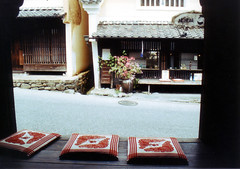 This small city in Ehime prefecture is a nice place to spend a few hours. The old merchant street with late Edo period buildings has been well preserved and it offers a look into what Japan used to be like.
This small city in Ehime prefecture is a nice place to spend a few hours. The old merchant street with late Edo period buildings has been well preserved and it offers a look into what Japan used to be like.
Currently listening to: Pearl Jam - Ten
Eden is reading: Angels and Demons - Dan Brown
Josh is reading: The Da Vinci Code - Dan Brown

 If you have the time, and are able to make it to the somewhat remote Iya Valley 祖谷, I highly recommend spending a night or more at Chiiori. Chiiori is a traditional thatched-roof farm house near Miune-san 三嶺山 in Higashi-Iya 東祖谷 village. It is maintained by a group of volunteers, and is more of a private residence or cooperative than a hotel. There are various work weekends throughout the year where you can help cut thatch for a new roof, help garden, or other work needed to keep the 300-year old structure standing. All guests sleep in the main hall on futons. Normally a Japanese house such as this would be partitioned into a few smaller rooms, but when Alex Kerr bought the place thirty years ago, he removed them to bring more sunlight into the rest of the house. Still, it is quite dark inside and adds to the romance of the place. Sitting around the hearth drinking tea, smoke billowing up to the rafters, rain and mist obscuring the trees and mountains was a wonderful experience.
If you have the time, and are able to make it to the somewhat remote Iya Valley 祖谷, I highly recommend spending a night or more at Chiiori. Chiiori is a traditional thatched-roof farm house near Miune-san 三嶺山 in Higashi-Iya 東祖谷 village. It is maintained by a group of volunteers, and is more of a private residence or cooperative than a hotel. There are various work weekends throughout the year where you can help cut thatch for a new roof, help garden, or other work needed to keep the 300-year old structure standing. All guests sleep in the main hall on futons. Normally a Japanese house such as this would be partitioned into a few smaller rooms, but when Alex Kerr bought the place thirty years ago, he removed them to bring more sunlight into the rest of the house. Still, it is quite dark inside and adds to the romance of the place. Sitting around the hearth drinking tea, smoke billowing up to the rafters, rain and mist obscuring the trees and mountains was a wonderful experience. No trip to the
No trip to the  Tsurugi-san is a sacred mountain in
Tsurugi-san is a sacred mountain in  The last free flowing river in
The last free flowing river in  This small city in Ehime prefecture is a nice place to spend a few hours. The old merchant street with late
This small city in Ehime prefecture is a nice place to spend a few hours. The old merchant street with late 
0 Comments:
Post a Comment
<< Home